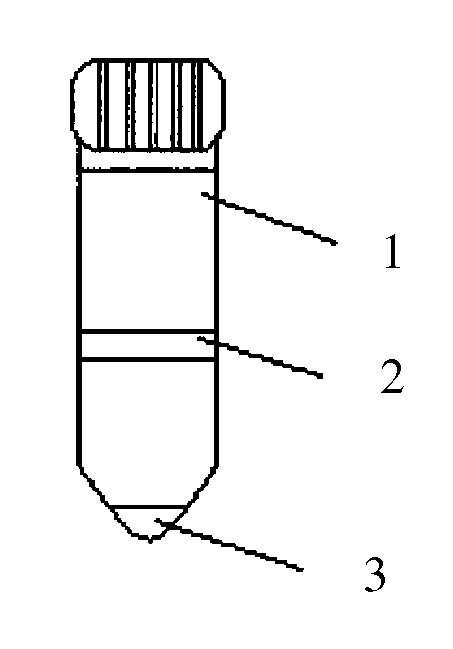Kits and methods for processing stem cells from bone marrow or umbilical cord blood
a technology of stem cells and kits, applied in the field of biotechnology, can solve the problems of affecting the activity of cells and cell therapy effectiveness, the method is associated with relatively high cost, and cannot be available to low- and middle-income patients
- Summary
- Abstract
- Description
- Claims
- Application Information
AI Technical Summary
Problems solved by technology
Method used
Image
Examples
example 1
Preparation of Stem Cell Processing Kits
[0081]The kit for stem cell processing of the present invention was prepared as follows. The density separation of stem cells comprised two steps. The first solution was used to begin the process, and the second solution was used to complete the process.
[0082]150 ml of the first solution was prepared using either a 0.1-30% (w / w) aqueous solution of hydroxyethyl starch, or a 0.1 to 30% (w / w) aqueous solution of methyl cellulose. 0.1-20% of cerebroprotein hydrolysate was added.
[0083]80 ml of the second solution was prepared as a separation reagent (density 1.0-1.2 g / ml) using Ficoll and meglumine diatrizoate. The second solution was prepared in large volumes, for example, in a 500 ml culture bottle, to eliminate the need of multiple procedures for stem cell isolation thereby reducing the risks of contamination.
[0084]The first and second solutions were sterilized under ultrafiltration conditions. Endotoxin levels in the first and second solutions...
example 2
Use of Kits for Stem Cell Processing (Samples 1-10)
[0087]Experimental Group (Group A)
[0088]Kits for stem cell processing were used as follows.
[0089](1) In both the experimental and control groups, blood samples were collected from the same voluntary donor's bone marrow blood or umbilical cord blood. After mixing with the anticoagulant solution (sodium citrate), the blood samples were divided into two equal portions of 50 ml or 90 ml each. One portion was added into a sterile culture bottle, and mixed with an equal volume of sodium chloride solution for injection.
[0090](2) The diluted sample was mixed with the first solution at a volume ratio of 2:1. The mixture was shaken for 1-8 minutes, let stand for 3 minutes to 3 hours to allow separation of layers, and the upper layer of cell suspension was drawn into a 50 ml centrifuge tube. The cell suspension was centrifuged for 1-20 minutes at 500-4000 rpm. The lower layer of cell suspension was collected to obtain the concentrated sample.
[...
example 3
A Systemic Lupus Erythematosus Patient Treated with Stem Cell Therapy
[0111]An adult female patient was diagnosed with systemic lupus erythematosus, lupus nephritis (Type IV), and chronic renal insufficiency (stage 5 chronic kidney disease). The patient exhibited facial swelling and severe edema of lower limbs, accompanied by dry mouth, fatigue, dark complexion, and low spirits. Urine lab results were as follows: urine protein 3+, urine occult blood 3+, nitrite 2+, erythrocytes 152.24 / HPF, leukocytes 1006.60 / HPF, bacteria 17368.36 / HPF, 24-hour urine protein quantitation 11.463 g / 24 h. Renal function results were: potassium 5.53 mmol / L, urea 25.33 mmol / L, creatinine 446 μmol / L. Complement C3 was 0.25 g / L, complement C4 was 0.09 g / L, and blood IgG was 20.40 g / L. Antinuclear antibody was +1:80, and anti-double stranded DNA was ++. Renal biopsy showed type IV lupus nephritis (active / chronic).
[0112]The patient received stem cell therapy, and completed three treatments within about 6 month...
PUM
| Property | Measurement | Unit |
|---|---|---|
| density | aaaaa | aaaaa |
| density | aaaaa | aaaaa |
| density | aaaaa | aaaaa |
Abstract
Description
Claims
Application Information
 Login to View More
Login to View More - R&D
- Intellectual Property
- Life Sciences
- Materials
- Tech Scout
- Unparalleled Data Quality
- Higher Quality Content
- 60% Fewer Hallucinations
Browse by: Latest US Patents, China's latest patents, Technical Efficacy Thesaurus, Application Domain, Technology Topic, Popular Technical Reports.
© 2025 PatSnap. All rights reserved.Legal|Privacy policy|Modern Slavery Act Transparency Statement|Sitemap|About US| Contact US: help@patsnap.com

